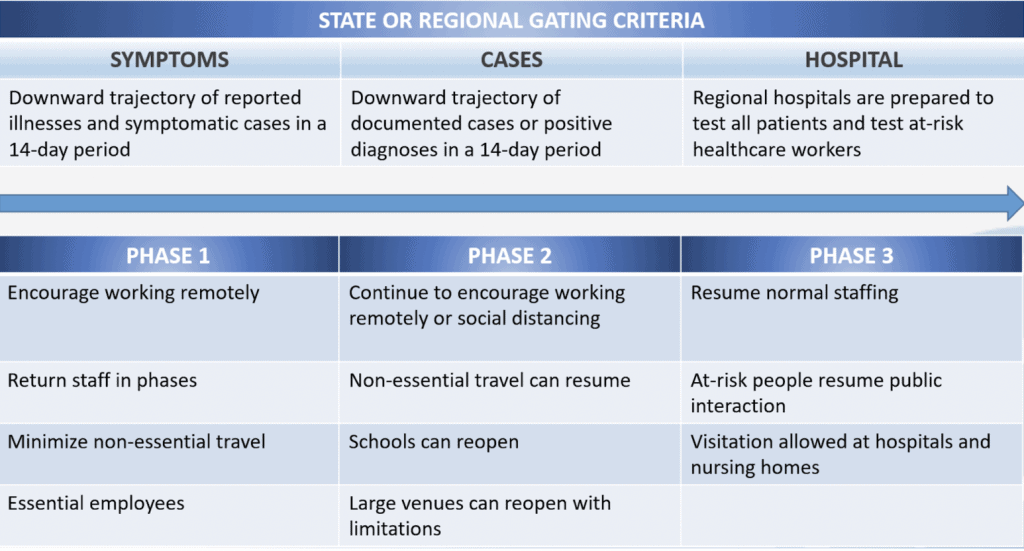As the country slowly emerges from COVID-19’s “shelter-in-place” restrictions, businesses will have to contend with a host of new realities with regard to social distancing and employee safety.
With that as a backdrop, on May 12, Receivables Management Association International (RMAI) hosted a webinar on:
Returning to the Workplace in a COVID-19 Environment
The webinar was led by:
- Eric Ziehlke, Inspreity
- Bill Dardano, Insperity
In this post, we’ll summarize the essential learning from RMAI’s webinar.
IMPORTANT NOTE: This post is not intended to be legal advice and may not be used as legal advice Legal advice must be tailored to the specific circumstances of each case.
GUIDELINES FOR OPENING AMERICA AGAIN
We start with understanding the expectations for opening the country back up for work. The chart below summarizes the federal guidelines for safely opening up the economy, covering three important phases. The top row outlines the essential “gateways” that should be met before moving into the next phase.
Corresponding to these gating criteria, we have suggested guidelines, for phasing in operations toward a goal of normal staffing and operations. Importantly, these are the White House’s suggested guidelines, and not mandatory rules. States and local municipalities have the flexibility to adjust these reflective of the situation in their areas. Moreover, every business has unique operational realities that will dictate their re-opening strategies (e.g., remote working is not practical for certain business sectors, such as manufacturing or restaurants).

The remainder of the webinar focused on issues that practical considerations employers must face as they begin to re-open.
PREPARE STAFF TO RETURN TO THE WORKFORCE
- Employee training. Spending time training managers will pay dividends in the long run, especially with regard to communication with your staff.
- Excellent organizational communication is a critical success factor, especially in an environment where there are so many unknowns. Do managers, supervisors and employees have the necessary skills to effectively communicate with one another during this transition?
- Everyone, especially managers, must be trained in identifying symptoms of COVID-19, and what protocols are in place to address situations where someone exhibits symptoms.
- With regard to business travel, be sure travel is essential. Also, before making travel plans, be sure you are aware of the visitor policies of the businesses you plan to visit.
- Business travel also covers employee commuting; if employees have been car-pooling previously, what measures are employees taking to ensure that pooling, if necessary, addresses social distancing guidelines?
- Business planning. Having a plan in place allows you to move forward with a sense of purpose and confidence.
- Identify essential personnel, such as those with critical roles, specific skills and expertise to the organization. Identifying these key players allows you to prioritize their return.
- Schedule employee returns in phases, based on their role and importance for the ramp-up phase of re-opening.
- Design a safe workplace that adheres to social distancing guidelines. Consider how you will layout work stations. Plan for employee traffic patterns in the office. Have protocols for cleaning office surfaces and make sure employees know what is expected of them in this regard.
- When acquiring supplies and equipment, know what is expected by local ordinances for your business type (i.e. protective shields required at grocery stores). This is especially true with regard to face coverings; be sensitive to the fact that not all employees may have coverings and do your best to accommodate them.
- Closely review your SOPs/policies, especially as they affect the work environment. Employee/employer dialogue is going to be critical during these times
- Create a communication plan that has long-term flexibility, because we are likely to be living with COVID-19 restrictions for some time.
- Communication
- Leadership should meet with supervisors and managers together first, to hammer out logistical details regarding how to bring employees back.
- Hold an all-company meeting at least one week prior to returning. Give employees enough time to take care of personal issues, like child or pet care plans. This is an important forum for answering questions, and there will be many. Be transparent with regard to how you came about your decision, such as how you decided on who was considered “essential” in the phasing process.
- Remind everyone that this is a fluid situation that can change as factors dictate.
RETURN YOUR STAFF TO A SAFE WORK ENVIRONMENT
- Employee screening: check with state, county, municipal sites to confirm what you can and cannot do.
- Self-reporting questionnaires reinforce the importance of understanding COVID-19 symptoms in order to minimize the chance of an infected employee entering the workforce.
- In some cases, physical screening can be conducted, but again, it must be in accordance with local guidelines in your area. For example, there may be local ordinances dictating that those who administer physical screens are required to wear specific personal protective equipment.
- Stay focused on social distancing efforts.
- Be sure to separate work stations as much as possible to meet social distancing guidelines.
- Also, to the degree possible, stagger shifts to minimize the number of people on premise at any one time.
- Put hygienic protocols in place.
- Employees should have access to proper resources.
- Give employees clear instructions about the storage and use of hygienic products, such as cleaning supplies.
- Post Department of Labor guidelines in a common area.
WHAT IF YOUR EMPLOYEE REFUSES TO RETURN TO WORK?
Businesses may face issues with employees who, for one reason or another, refuse to return to the work force. In this regard, there are a few steps you can take to address and diffuse the situation.
- It is important to take the time to talk to them. Take a step back and look at the situation from their perspective. Recognize that, often, fear causes people to be rigid and uncooperative.
- You may find that the most successful path to diffusing a situation is to simply explain why their role is essential to your business. Hearing a manager reinforce their importance to the organization can go a long way to bolstering their confidence.
- At the same time, explain the steps you’ve taken to address the situation. Let them know what you are doing to ensure the safest workplace possible. Go into detail about your protocols and also let them know what resources you are making available to ensure their safety.
- If you haven’t been able to make headway in this first discussion, keep talking, by going a little deeper.
- Seek to understand why they don’t want to return. You might learn that there are certain personalsituations that are causing them fear. For example, if they are caring for an elderly parent or a partner who has gone through chemotherapy, it would be understandable that they are experiencing a lot of fear.
- Depending on where the dialogue goes, it may be necessary to explore legal options, such as an accommodation through the Americans With Disabilities Act. But, overall, do your best to think creatively to solve unique issues. If they are caring for a parent at home, you may look at extending their work-from-home status, ensuring they have what they need to perform their job to its fullest extent.
- If the aforementioned discussions proves unsuccessful, and you are unable to accommodate the employee:
- Seek guidance from HR professional or your attorney.
- It may also be necessary to enter into disciplinary process.
- However, to the degree possible, try your absolute best to avoid disciplinary action, especially termination.
Reference Guide
Following are reference links that might come in handy as you begin the process of returning your business to work.
Center for Disease Control
General Information: https://www.cdc.gov/coronavirus/2019-ncov/index.html
Guide for Employers: https://www.cdc.gov/coronavirus/2019-ncov/community/guidance-business-response.html
OSHA
General Information: https://www.osha.gov/SLTC/covid-19/
Guide for Employers: https://www.osha.gov/SLTC/covid-19/controlprevention.html#interim
EPA
General Information: https://www.epa.gov/coronavirus
Guide for Employers: https://www.epa.gov/coronavirus/epa-guidance-disinfecting-cleaning-and-addressing-water-quality-challenges-related
Error: Contact form not found.





